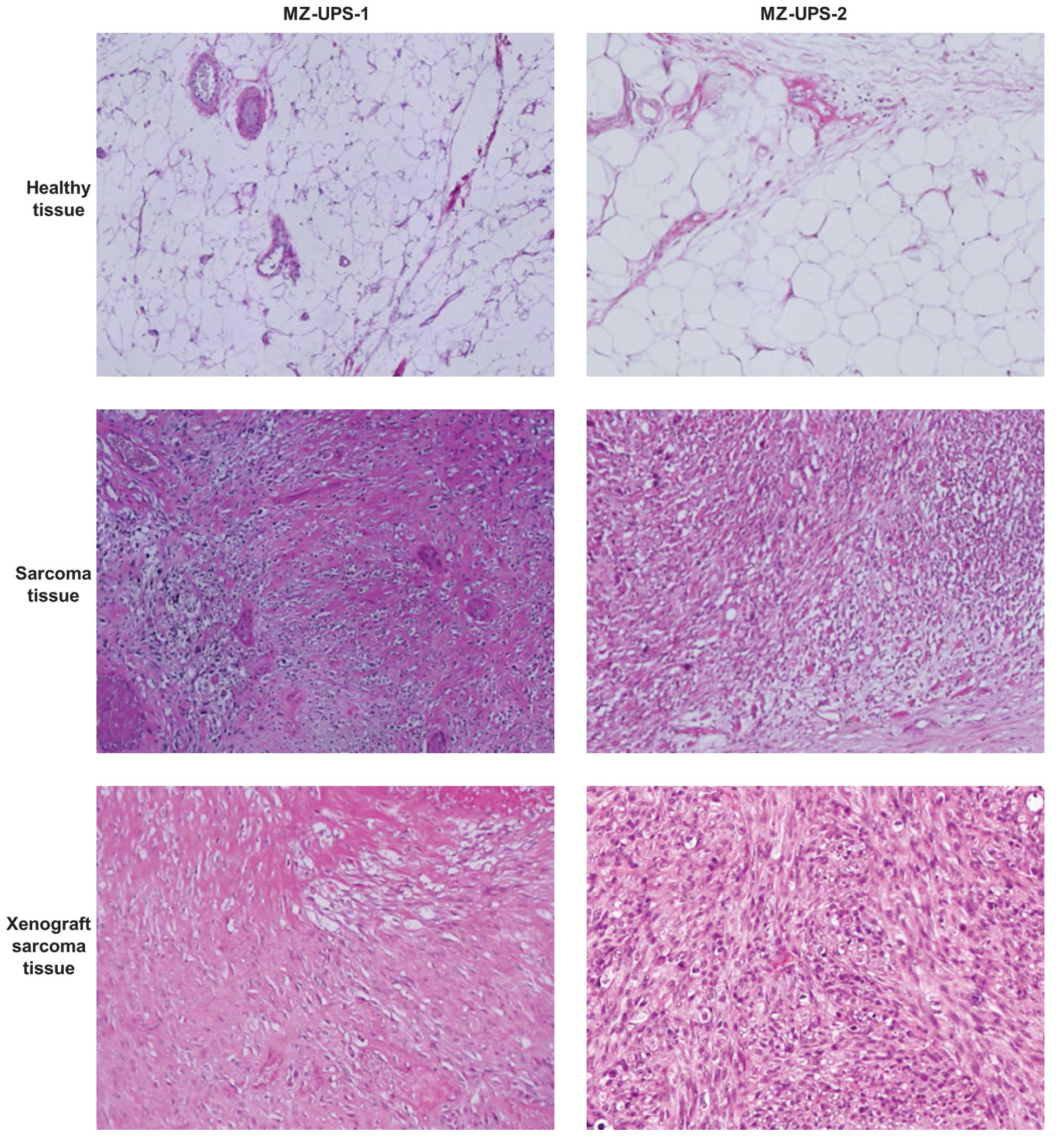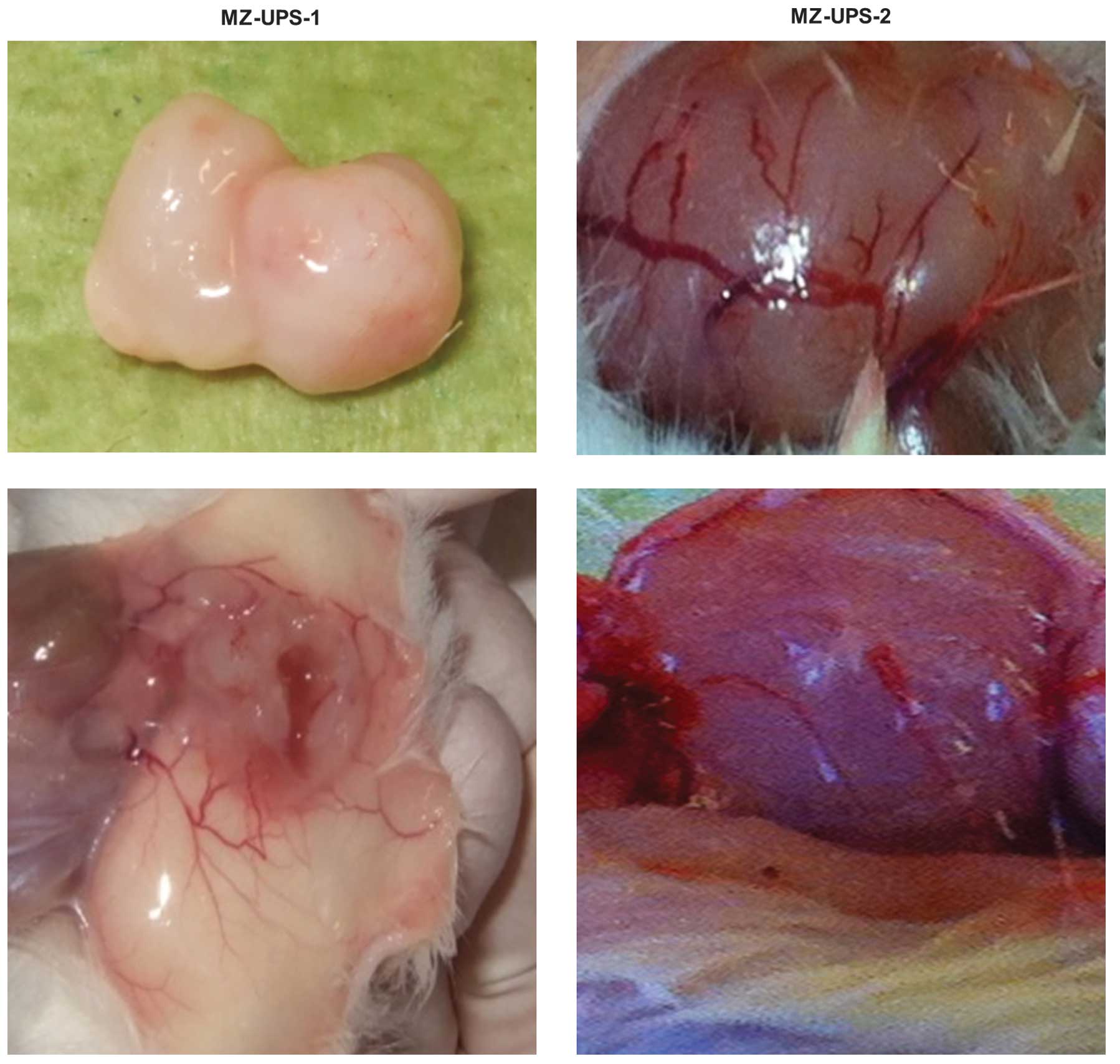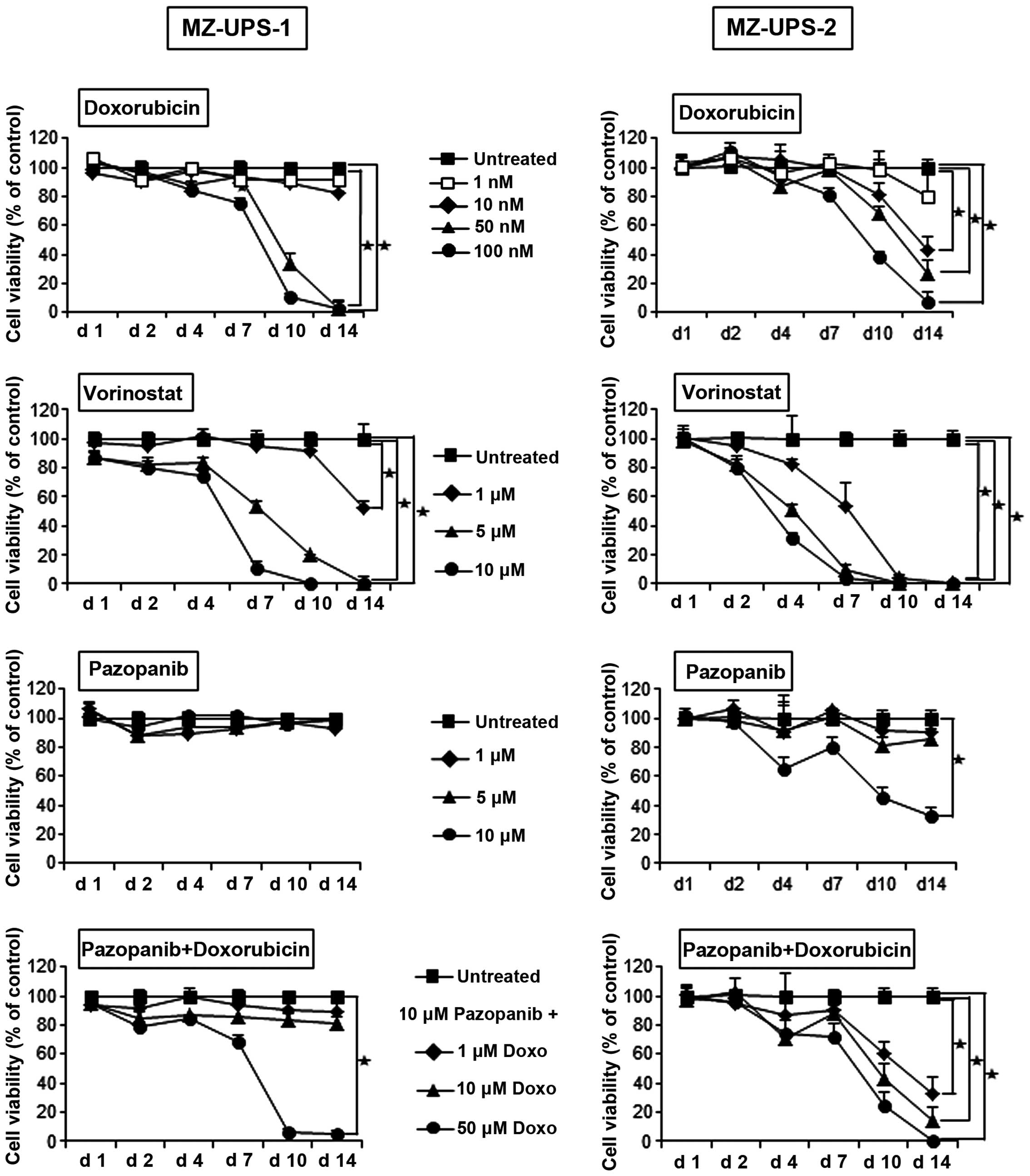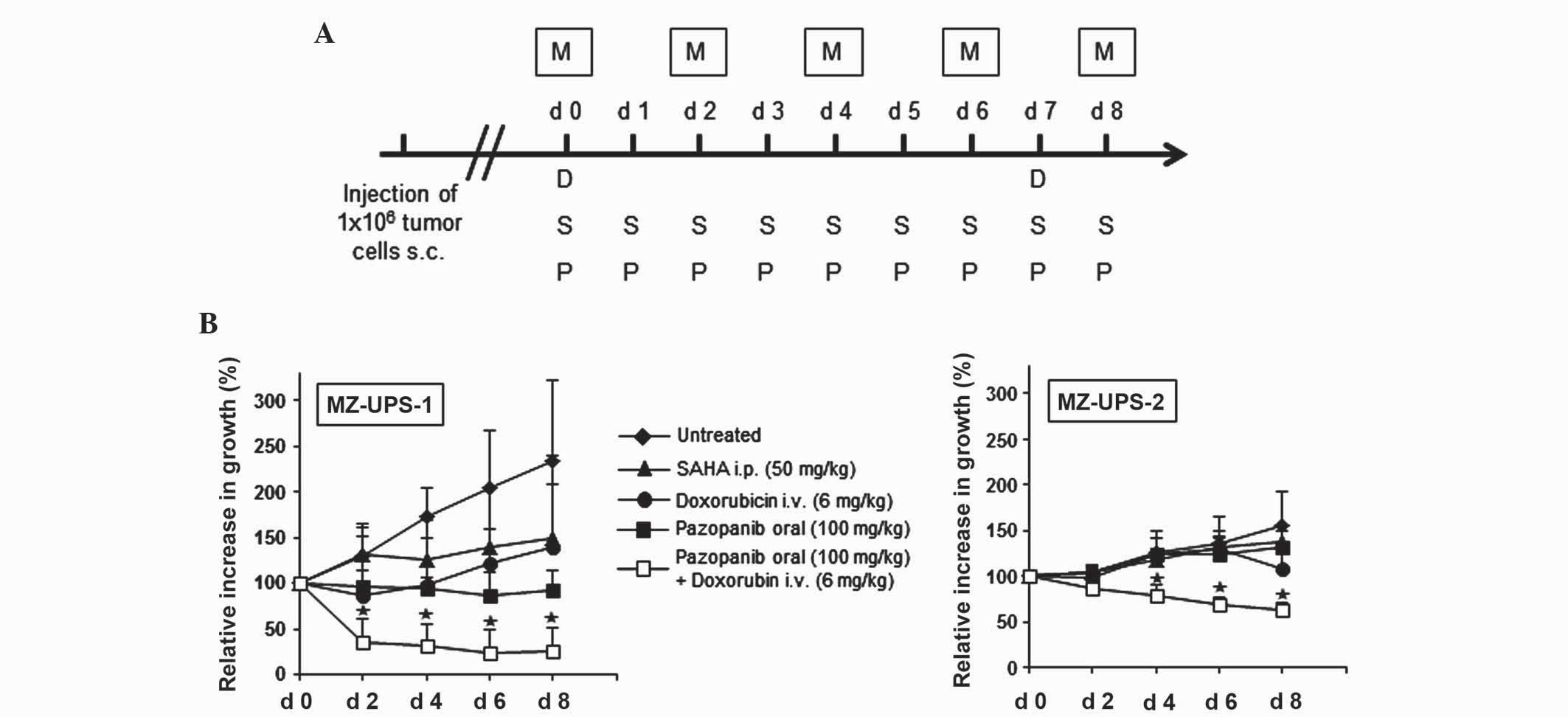|
1
|
Iwasaki H, Isayama T, Johzaki H and
Kikuchi M: Malignant fibrous histiocytoma. Evidence of perivascular
mesenchymal cell origin immunocytochemical studies with monoclonal
anti-MFH antibodies. Am J Pathol. 128:528–537. 1987.PubMed/NCBI
|
|
2
|
Katenkamp K and Katenkamp D: Soft tissue
tumors: New perspectives on classification and diagnosis. Dtsch
Arztebl Int. 106:632–636. 2009.PubMed/NCBI
|
|
3
|
Poremba C: Soft tissue sarcomas: The role
of histology and molecular pathology for differential diagnosis.
Verh Dtsch Ges Pathol. 90:59–72. 2006.(In German). PubMed/NCBI
|
|
4
|
Al-Agha OM and Igbokwe AA: Malignant
fibrous histiocytoma: Between the past and the present. Arch Pathol
Lab Med. 132:1030–1035. 2008.PubMed/NCBI
|
|
5
|
Matushansky I, Charytonowicz E, Mills J,
Siddiqi S, Hricik T and Cordon-Cardo C: MFH classification:
Differentiating undifferentiated pleomorphic sarcoma in the 21st
Century. Expert Rev Anticancer Ther. 9:1135–1144. 2009. View Article : Google Scholar : PubMed/NCBI
|
|
6
|
Spira AI and Ettinger DS: The use of
chemotherapy in soft-tissue sarcomas. Oncologist. 7:348–359. 2002.
View Article : Google Scholar : PubMed/NCBI
|
|
7
|
Grimer R, Judson I, Peake D and Seddon B:
Guidelines for the management of soft tissue sarcomas. Sarcoma.
2010:5061822010. View Article : Google Scholar : PubMed/NCBI
|
|
8
|
Italiano A, Mathoulin-Pelissier S, Cesne
AL, Terrier P, Bonvalot S, Collin F, Michels JJ, Blay JY, Coindre
JM and Bui B: Trends in survival for patients with metastatic
soft-tissue sarcoma. Cancer. 117:1049–1054. 2011. View Article : Google Scholar : PubMed/NCBI
|
|
9
|
Daigeler A, Klein-Hitpass L, Stricker I,
Müller O, Kuhnen C, Chromik AM, Steinstraesser L, Goertz O, Steinau
HU and Lehnhardt M: Malignant fibrous histiocytoma - pleomorphic
sarcoma, NOS gene expression, histology, and clinical course. A
pilot study. Langenbecks Arch Surg. 395:261–275. 2010. View Article : Google Scholar : PubMed/NCBI
|
|
10
|
Fletcher CDM, Unni KK and Mertens F: World
Health Organisation Classification of Tumours. Pathology and
Genetics of Tumours of Soft Tissue and Bone. IARC Press. (Lyon).
2002.
|
|
11
|
Casali PG and Blay JY:
ESMO/CONTICANET/EUROBONET Consensus Panel of experts: Soft tissue
sarcomas: ESMO Clinical Practice Guidelines for diagnosis,
treatment and follow-up. Ann Oncol. 21(Suppl 5): v198–v203. 2010.
View Article : Google Scholar : PubMed/NCBI
|
|
12
|
Italiano A, Le Cesne A, Mendiboure J, Blay
JY, Piperno-Neumann S, Chevreau C, Delcambre C, Penel N, Terrier P,
Ranchere-Vince D, et al: Prognostic factors and impact of adjuvant
treatments on local and metastatic relapse of soft-tissue sarcoma
patients in the competing risks setting. Cancer. 120:3361–3369.
2014. View Article : Google Scholar : PubMed/NCBI
|
|
13
|
Leahy M, Del Garcia Muro X, Reichardt P,
Judson I, Staddon A, Verweij J, Baffoe-Bonnie A, Jönsson L, Musayev
A, Justo N, et al: SABINE Investigators: Chemotherapy treatment
patterns and clinical outcomes in patients with metastatic soft
tissue sarcoma. The SArcoma treatment and Burden of Illness in
North America and Europe (SABINE) study. Ann Oncol. 23:2763–2770.
2012. View Article : Google Scholar : PubMed/NCBI
|
|
14
|
van der Graaf WT, Blay JY, Chawla SP, Kim
DW, Bui-Nguyen B, Casali PG, Schöffski P, Aglietta M, Staddon AP,
Beppu Y, et al: EORTC Soft Tissue and Bone Sarcoma Group; PALETTE
study group: Pazopanib for metastatic soft-tissue sarcoma
(PALETTE): A randomised, double-blind, placebo-controlled phase 3
trial. Lancet. 379:1879–1886. 2012. View Article : Google Scholar : PubMed/NCBI
|
|
15
|
Ray-Coquard I and Thomas D: Targeted
therapies: Pazopanib for soft-tissue sarcoma: A PALETTE of data
emerges. Nat Rev Clin Oncol. 9:431–432. 2012. View Article : Google Scholar : PubMed/NCBI
|
|
16
|
Nguyen DT and Shayahi S: Pazopanib:
Approval for soft-tissue sarcoma. J Adv Pract Oncol. 4:53–57.
2013.PubMed/NCBI
|
|
17
|
Ranieri G, Mammì M, Di Donato Paola E,
Russo E, Gallelli L, Citraro R, Gadaleta CD, Marech I, Ammendola M
and De Sarro G: Pazopanib a tyrosine kinase inhibitor with strong
anti-angiogenetic activity: A new treatment for metastatic soft
tissue sarcoma. Crit Rev Oncol Hematol. 89:322–329. 2014.
View Article : Google Scholar : PubMed/NCBI
|
|
18
|
Tavallai S, Hamed HA, Grant S, Poklepovic
A and Dent P: Pazopanib and HDAC inhibitors interact to kill
sarcoma cells. Cancer Biol Ther. 15:578–585. 2014. View Article : Google Scholar : PubMed/NCBI
|
|
19
|
Schöffski P, Cornillie J, Wozniak A, Li H
and Hompes D: Soft tissue sarcoma: An update on systemic treatment
options for patients with advanced disease. Oncol Res Treat.
37:355–362. 2014. View Article : Google Scholar : PubMed/NCBI
|
|
20
|
Nakatani T, Marui T, Yamamoto T, Kurosaka
M, Akisue T and Matsumoto K: Establishment and characterization of
cell line TNMY1 derived from human malignant fibrous histiocytoma.
Pathol Int. 51:595–602. 2001. View Article : Google Scholar : PubMed/NCBI
|
|
21
|
Krause AK, Hinrichs SH, Orndal C, DeBoer
J, Neff JR and Bridge JA: Characterization of a human myxoid
malignant fibrous histiocytoma cell line, OH931. Cancer Genet
Cytogenet. 94:138–143. 1997. View Article : Google Scholar : PubMed/NCBI
|
|
22
|
Mairal A, Chibon F, Rousselet A, Couturier
J, Terrier P and Aurias A: Establishment of a human malignant
fibrous histiocytoma cell line, COMA. Characterization by
conventional cytogenetics, comparative genomic hybridization, and
multiplex fluorescence In situ hybridization. Cancer Genet
Cytogenet. 121:117–123. 2000. View Article : Google Scholar : PubMed/NCBI
|
|
23
|
Hakozaki M, Hojo H, Sato M, Tajino T,
Yamada H, Kikuchi S and Abe M: Establishment and characterization
of a new cell line, FPS-1, derived from human undifferentiated
pleomorphic sarcoma, overexpressing epidermal growth factor
receptor and cyclooxygenase-2. Anticancer Res. 26(5A): 3393–3401.
2006.PubMed/NCBI
|
|
24
|
Nishio J, Iwasaki H, Nabeshima K, Ishiguro
M, Isayama T and Naito M: Establishment of a new human pleomorphic
malignant fibrous histiocytoma cell line, FU-MFH-2: Molecular
cytogenetic characterization by multicolor fluorescence in
situ hybridization and comparative genomic hybridization. J Exp
Clin Cancer Res. 29:1532010. View Article : Google Scholar : PubMed/NCBI
|
|
25
|
Steinstraesser L, Jacobsen F, Schubert C,
Gevers K, Stricker I, Steinau HU and Al-Benna S: Establishment of a
primary human sarcoma model in athymic nude mice. Hum Cell.
23:50–57. 2010. View Article : Google Scholar : PubMed/NCBI
|
|
26
|
Tilkorn DJ, Daigeler A, Hauser J, Ring A,
Stricker I, Schmitz I, Steinstraesser L, Steinau HU and Al-Benna S:
A novel xenograft model with intrinsic vascularisation for growing
undifferentiated pleomorphic sarcoma NOS in mice. J Cancer Res Clin
Oncol. 138:877–884. 2012. View Article : Google Scholar : PubMed/NCBI
|
|
27
|
Tilkorn DJ, Stricker I, Hauser J, Ring A,
Schmitz I, Steinstraesser L, Steinau HU, Daigeler A and Al-Benna S:
Experimental murine model of primary high grade undifferentiated
pleomorphic sarcoma not otherwise specified. In Vivo.
26:559–563. 2012.PubMed/NCBI
|
|
28
|
Fletcher CDM, Bridge JA, Hogendoorn P and
Mertens F: World Health Organization Classification of Tumours of
Soft Tissue and Bone (4th). 5:IARC. Lyon: 2013.
|
|
29
|
Radaelli S, Stacchiotti S, Casali PG and
Gronchi A: Emerging therapies for adult soft tissue sarcoma. Expert
Rev Anticancer Ther. 14:689–704. 2014. View Article : Google Scholar : PubMed/NCBI
|
|
30
|
Reichardt P: Soft tissue sarcomas, a look
into the future: Different treatments for different subtypes.
Future Oncol. 10(Suppl 8): s19–s27. 2014. View Article : Google Scholar : PubMed/NCBI
|
|
31
|
Villacis RA, Silveira SM, Barros-Filho MC,
Marchi FA, Domingues MA, Scapulatempo-Neto C, Aguiar S Jr, Lopes A,
Cunha IW and Rogatto SR: Gene expression profiling in
leiomyosarcomas and undifferentiated pleomorphic sarcomas: SRC as a
new diagnostic marker. PLoS One. 9:e1022812014. View Article : Google Scholar : PubMed/NCBI
|
|
32
|
Villacis RA, Silveira SM, Barros-Filho MC,
Marchi FA, Domingues MA, Scapulatempo-Neto C, Aguiar S Jr, Lopes A,
Cunha IW and Rogatto SR: Gene expression profiling in
leiomyosarcomas and undifferentiated pleomorphic sarcomas: SRC as a
new diagnostic marker. PLoS One. 9:e1022812014. View Article : Google Scholar : PubMed/NCBI
|
|
33
|
Versleijen-Jonkers YM, Vlenterie M, van de
Luijtgaarden AC and van der Graaf WT: Anti-angiogenic therapy, a
new player in the field of sarcoma treatment. Crit Rev Oncol
Hematol. 91:172–185. 2014. View Article : Google Scholar : PubMed/NCBI
|
|
34
|
Tentler JJ, Tan AC, Weekes CD, Jimeno A,
Leong S, Pitts TM, Arcaroli JJ, Messersmith WA and Eckhardt SG:
Patient-derived tumour xenografts as models for oncology drug
development. Nat Rev Clin Oncol. 9:338–350. 2012. View Article : Google Scholar : PubMed/NCBI
|


















